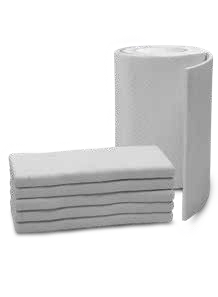DCT CERAMIC FIBRE
DCT Ceramic Fibre is an insulating material that is used for applications in between 750°C and 1430°C. DCT Ceramic Fibre blankets are used for industrial furnace insulation, boiler, pipe and chimney insulation, and other technical capacities which require high temperature insulation.
Our ceramic fibre consists of (spun technology) long, flexible and combined woven fibres of silica, aluminium and zirconium. DCT Ceramic Fibre Insulation has very low shot (unfiberised) content with the amount of high pure silica and aluminium. No chemical binders are used in the production of our ceramic fibre and it will not smoke or emit odours upon use.
DCT Ceramic Fibre is not affected by chemicals (except phosphoric and hydrofluoric acid and strong alkalis such as Na2O, K2O). It retains the same thermal and characteristic properties after being wetted and dried. Our Ceramic Fibre has a long fibre structure, thanks to production technology no chemical binder is needed for its production.
PRODUCT LINES
DCT CF Blanket
Product Sizes:
Rolls: 25 x 610 x 7200mm
Rolls: 50 x 610 x 3600mm,
Rolls: 13 x 610 x 14400mm
DCT CF Bulk
Product Size:
Packaged in quantities of 13-14 kilos

BROCHURE DOWNLOAD
FEATURES & APPLICATIONS
Ceramic Fibre Blanket
Applications
- Industrial furnace insulation
- Ceramics – Glass industry
- Iron and steel industry
- Casting industry
- Cement industry
- Industrial furnace insulation
- Steel door – Fire door
- Boiler, pipe, chimney, raw material storage tanks
- Other applications where high temperature insulation is between 750°C and 1430°C is required.
Features
- High tensile strength and high elasticity
- Low thermal conductivity value
- High thermal resistance value
- Good sound absorption properties
- Low temperature storage
- Minimal shrinkage at high temperature
- Not affected by thermal shock
Bulk Ceramic Fibre
Applications
- In industrial applications
- In filling gaps between device and walls
- In high boiler and furnace insulation
where plate or blankets can not be
applied - On hot surfaces (mold pressed to form)
as heat insulation filler material - Production of materials for the foundry
industry and raw materials in tundish
refractories
Features
- Low dust content
- Homogeneous distribution
- Minimal shrinkage at high temperature
